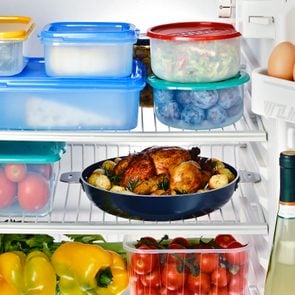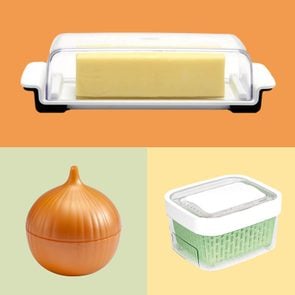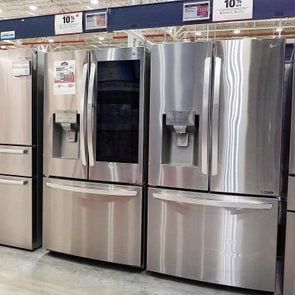How to Refrigerate Almost Every Type of Food
Updated: Nov. 03, 2023
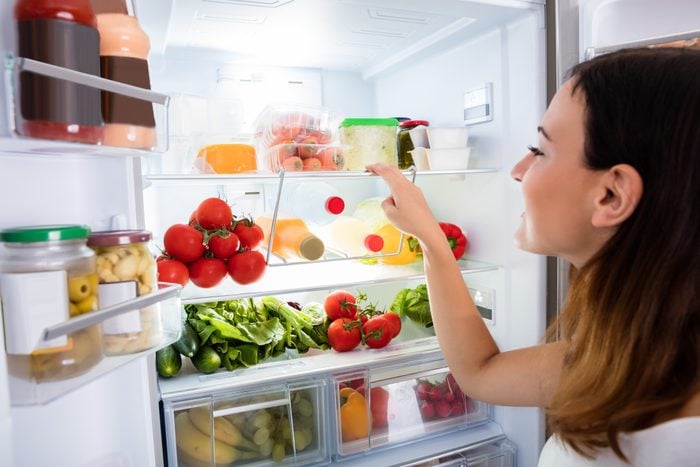
Want to reduce food waste and save money on groceries? Learn how to store food properly in the refrigerator.
Has there ever been a kitchen invention more crucial than the refrigerator? This mighty modern marvel not only keeps food and beverages chilled for better enjoyment, but it also actively helps us reduce food waste, save money, extend the shelf life of milk and other items, and keep all sorts of foods—from fruit to seafood to eggs—fresh and safe longer.
No wonder, then, that mini fridges are on dorm dwelling move-in lists even when microwaves are not. The appliance is so useful that, even if a studio apartment doesn’t come with a stove or hot plate, people will still invest in a small fridge first.
So don’t take the technology for granted—make fridge organization a priority. (While you’re at it, go ahead and organize your freezer and all the non-perishable foods in your pantry too.) You may be surprised how easy it is to consume items before their best-by or sell-by dates when you can actually find them in the fridge. To help you tidy up, we asked appliance experts and professional chefs for their top tips on how to store pretty much any type of food in the refrigerator.
Get Reader’s Digest’s Read Up newsletter for more tips on food, cleaning, travel and tech, plus humor and fun facts, all week long.
Getting to know your fridge
With every refrigerator, there’s usually only one temperature control, which is separate from your freezer’s temperature setting. Knowing that, you would think the entire fridge interior is fair game for all foods. But Katie Gespass, the refrigerator buyer for regional appliance chain P.C. Richard & Son, would beg to differ. “According to the FDA, it’s best to keep this temperature below 40 degrees Fahrenheit, but the ideal temperature is lower, around 36 to 38 degrees Fahrenheit,” she says.
Brita Lundberg, of Lundberg Family Farms, a specialty naturally farmed rice brand, suggests checking your refrigerator periodically to make sure the temperature settings are working properly. “Keeping a thermometer in the fridge can be really helpful,” she says.
Regardless, it’s better to err on the side of caution and go with a cooler fridge temperature, because refrigerators have different zones. “The refrigerator door is the warmest place,” says Gespass. “It’s best for condiments. The upper shelves have the most consistent temperature, but the lower shelves are the coldest. A good rule of thumb is to store foods such as berries, hummus, olives and food that does not have to be cooked on the upper shelves. Foods such as raw meats, seafood, eggs and dairy should be stored on the lowest shelves.”
This organization method will help you keep food at the right temperature to avoid foodborne illness. And it’ll also help prevent food that is meant to be eaten uncooked from getting contaminated if meat packages should leak.
Most modern refrigerators also offer deli and crisper drawers, which are often marked with images to signal their use. Their placement allows them to best take advantage of those different refrigerator zones. They may also have humidity settings that can help you maximize the time you have with your ingredients.
How to store meat
Meat storage guidelines are perhaps one of the most important refrigerator organization rules to adhere to. The last Centers for Disease Control and Prevention estimate of foodborne illnesses that resulted in hospitalization showed that roughly 46% were the result of improper storage of meat and seafood.
It certainly doesn’t help that different types of meat spoil at different rates. How long chicken lasts is not the same as how long deli meat lasts, and even those numbers vary based on whether it’s cooked, vacuum sealed or stored raw in store or butcher packaging.
For uncooked meat, Nigel Palmer, executive R&D chef for the national meal kit delivery company Home Chef, says it’s important to always keep it at the bottom of the refrigerator. “Storing it there reduces the risk of cross-contamination from any juices that might leak out of the meat,” he says.
You can also buy clear bins that you reserve for items that might leak. For additional safety, put the meat in a bowl or on a plate “to eliminate the need to clean and sanitize the shelf you store it on,” he says.
Keeping meat toward the back of the fridge will help inhibit the growth of bacteria too, as that location is less susceptible to the temperature changes that occur every time you open the door.
How to store fish and seafood
Fish ranks among the most heart-healthy foods, which is why you’ll absolutely want to keep your fridge stocked with it. It does, however, pose certain storage challenges.
For anyone wondering how long fish lasts, the short answer is not very long. That’s why it’s especially important to store it properly in your refrigerator. Michael B. Nelson, executive chef of GW Fins Restaurant in New Orleans, cannot emphasize this enough. “Only buy fish if you plan on cooking it right away,” he tells Reader’s Digest. “Keep raw fish in the coldest spot, loosely wrapped in paper towels laid out in one layer. If you have skin-on fillets or whole fish, I recommend leaving it uncovered to allow the skin to dry a bit so it can cook up crisper.”
His recommendations for shellfish are a little different, though. “Shellfish does not like to be too cold,” Nelson says. “Keep shellfish in a perforated pan with something underneath to catch drips—you don’t want to store it in liquid. Keep a large Ziploc bag with ice on top to ensure it stays cold, but don’t let shellfish freeze. That will kill them.”
How to store dairy and eggs
Back in the day, some refrigerators came with egg cartons built into the doors. This is no longer the case, and for a good reason. While it is safe to eat expired eggs, especially when you know how to tell if eggs are still good, Egg Farmers of Canada believes that eggs are best kept in the main body of the refrigerator, toward the middle, so they stay consistently cool.
And contrary to tradition, you should keep milk out of the door as well. As Gespass notes, milk should be kept in the coldest part of the refrigerator—no matter where in your model that may be. That will extend the shelf life of your carton of milk.
Butter, however, can go in the door. While butter does expire, it’ll last awhile—even on the counter—in the proper receptacle.
Finally, while different types of cheese require different receptacles, materials and conditions, the Dairy Farmers of Wisconsin generally recommend storing cheese in the deli drawer or veggie crisper. Those closed compartments are kept even more stable than the rest of the fridge, and the higher temperatures and humidity will help preserve the cheese’s flavor and moisture and will protect it from absorbing the flavors of other foods.
No deli drawer in your refrigerator model? No worries. You can make your own drawers by buying plastic ones you can just pop right onto the shelf.
How to store fruit and vegetables
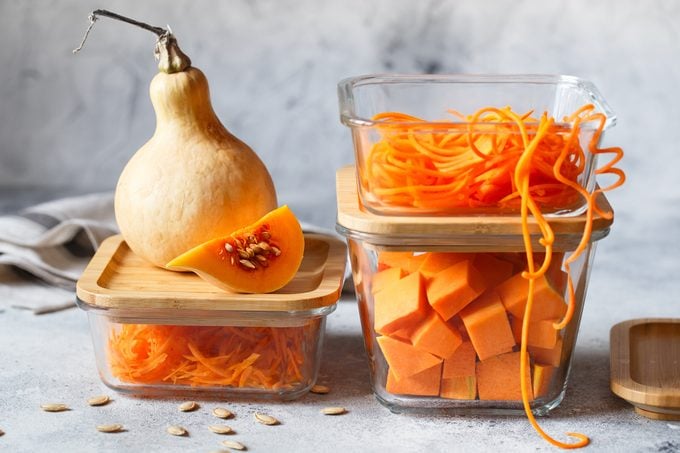
Fruit and vegetable storage is a hot topic as people aim to make like a dietitian and eat more of these cancer-fighting foods. No matter the season, people want to know tricks for making fruit last longer, how to keep their greens from wilting and whether fruit or veggies should be stored differently after they’ve been cut. Thankfully, we got the scoop from the experts.
How to store whole fruit and veggies
“Where to store fruit depends on the fruit,” says Palmer. “Some, like bananas and stone fruit, should never be put in the refrigerator. Consume these as soon as they are ripe. But delicate berries should be placed away from the spot where cold air blows into the refrigerator. Soft perishables, like mushrooms, grapes and herbs, should definitely stay chilled, though. Fruit with rinds, like citrus fruits, apples or pears, do well in refrigerator drawers.”
But do you have to put your fruit in the fridge? Absolutely not! “None of those actually require refrigeration if you have another cool, dry spot to keep them,” he says.
The same goes for vegetables like potatoes, onions and hard winter squashes, in his expert opinion. For those, a dark place in the pantry is a perfect storage spot—just keep in mind that you shouldn’t store certain fruits and veggies together. “Whether in the refrigerator or not, it’s always best to store potatoes and onions in separate spots, since onions can cause potatoes to sprout.”
Other veggies are also fine to store outside the fridge. “Actually, vegetables like tomatoes have better flavor and texture when stored on the counter,” he points out.
Of course, you may not have room for tons of fruits and vegetables on the counter, and that’s OK. They can go in the fridge, and they’ll taste fine, provided you place them in the right spot. “When in doubt, most vegetables store well in the refrigerator’s crisper drawers,” Palmer says. That’s where you can keep leafy greens, zucchini, carrots, radishes, cabbage, broccoli, green beans and more. Next, find out how to use a vinegar fruit wash to make your produce last longer.
How to store cut fruit and veggies
The best way to store food depends on its form. While plenty of fruits and vegetables can hang out on the counter, you’ll need to take more care with sliced produce. This also makes picking the food storage container carefully all the more important.
Store all cut fruits and vegetables covered—glass storage containers are a great option. “It helps to store them in glass or stainless steel containers because they don’t hang on to residual smells or flavors from the previous contents,” Palmer says.
Salad greens in plastic clamshell containers can be kept in their packaging and in the coldest part of the fridge with a sheet of paper towel to absorb moisture. Even better than that DIY storage trick? Produce keeper bins that keep your greens elevated and aerated to reduce rot.
As for onions, once they’ve been sliced, they need to be kept chilled and in an airtight container, which makes gadgets like this onion keeper very handy.
How to store herbs

Fresh herbs can elevate a dish, but storing them poses a problem for many a home cook. Do you keep them on the counter? Shove ’em in the fridge? Are you doomed to wilted herbs no matter what?
Take heart: Palmer’s tips for how to store fresh herbs will help you keep those herbs fresh for days. “Heartier herbs, like rosemary and thyme, store well in the refrigerator,” he says. “They should be loosely covered so condensation doesn’t build up and promote spoilage. For more tender herbs, like parsley and cilantro, you can put them stem side down in a glass or a cup with a small amount of water in the bottom. Similar to a flower arrangement, the water will help to keep them hydrated and fresh. They can then be loosely wrapped and stored in the refrigerator away from where the cold air blows in.”
Even better, you can invest in an herb-keeper that houses delicate ones, small bunches and longer-stemmed varieties in optimal conditions.
How to store condiments
Contrary to what you may think, condiments do expire. Many, including mustard, barbecue sauce, mayonnaise, ketchup—whose refrigeration is a point of contention!—and cooking sauces are formulated to be shelf stable for a longer sell-by date … until they’re opened. After the seal is broken, most do need to be refrigerated.
Per Gespass, these can be kept in the door, as they’re less sensitive to changes in temperature.
How to store leftovers
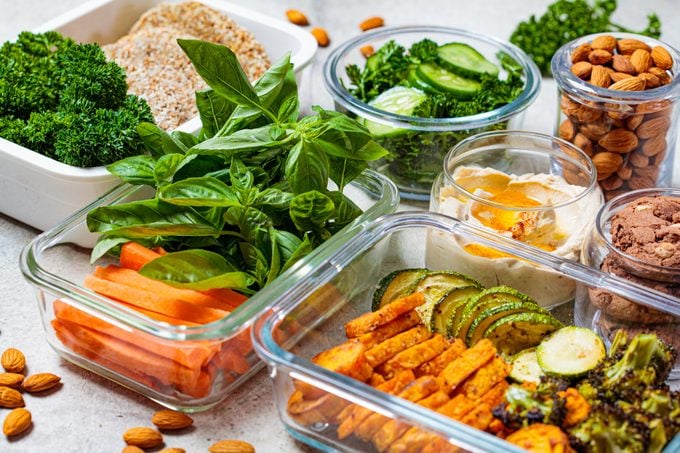
Realistically, one of the things we most need fridge space for is storing already-cooked extra food. How to store leftovers can often vary, but a general rule of thumb is to refrigerate them right away (within two hours of cooking), even if they’re still a little warm. Let them sit out for longer, and you risk bacteria that can cause foodborne illness.
It’s also best to keep them at the front of the fridge to remind you that they exist. Since you shouldn’t keep them for more than three to five days, depending on the food preparation and ingredients, it’s more important to consume them quickly as opposed to keeping the temperature the most consistent, as is a priority for longer-term food storage.
From there, use the expert-approved tips below to keep your leftovers fresh and tasting their best on day two.
Choose the right container
Palmer likes glass containers with tight-fitting tops best but points out that reusing other types of containers is perfectly fine for leftover short-term storage. “Most of us are looking for ways to reduce our waste, so don’t be afraid to clean and repurpose appropriate containers from grocery items or takeout to store ingredients and leftovers.”
Give canned foods a new home
If the food originally came in a can, put it in a different food-storage container—whether that’s glass, plastic or silicone—because the metal on the rim of the can has the potential to leach into the food.
Cover up strong-smelling foods
Do yourself (and your housemates) a favor and keep strongly scented leftovers under wraps. “Don’t leave items with pungent odors, like cut onions and mustard, uncovered in the refrigerator,” Palmer says. “Items like eggs and soft cheeses can absorb those odors, and it can change their flavor.”
Keep grains in an airtight container
For grain dishes, airtight is best, according to rice specialist Lundberg. “Before you pop it in the fridge, make sure you allow the rice to cool, though,” she advises. “Once cooked, I like to spread any extra rice out on a baking sheet or in a flat dish. This allows the steam to escape and the rice to cool down. Then, after no more than an hour, I transfer it to a lidded, closed container and put it in the refrigerator. This process helps keep the rice from the ‘danger zone’ of 40 to 140 degrees Fahrenheit and avoids trapping hot moisture in the container.” If you’re curious, here is how long rice lasts in the fridge.
Avoid dried-out pasta
Leftovers from a pasta dinner are almost inevitable, but the downside is that macaroni tends to be overly dry when reheated. The trick to tasty reheated pasta, says Kevin Grossman, the executive chef of La Tavola in Atlanta, is using a heavy-duty plastic storage bag for plain pasta without sauce.
“You really want to avoid having your pasta get dry once it’s cooked,” he says. “A Ziploc bag can store in any location easily and keeps the pasta from drying out.”
But if you plan to turn the dry noodles into baked pasta the following night, he recommends using a glass container. (It’s his go-to method for storing pasta with sauce as well.) “Then I’ll add a little more sauce on top and make sure it’s covered,” he says. “The pasta will undoubtedly absorb moisture as it sits.”
You can also toss it in oil to prevent stickiness and gumminess.
Store with tomorrow’s meal in mind
Instead of tossing leftovers from the pot into the fridge and calling it a night, consider how you’ll use them when reheating. Grossman suggests turning cooked pasta into a baked dish with extra sauce, cheese and more.
“Store it in the container you plan to bake in, and you’ll have a meal ready to pop in the oven,” he says. Otherwise, he likes to save some of the original pasta water to add when reheating the dish. “The flavor, salt and starch will make all the difference.”
How to store food for even longer
Want to keep meat and fish fresh for a couple days, store produce for a week or more, or make sure condiments say safe to eat until they expire? Your refrigerator is your best friend. But there’s only so much it can do, and if you want to keep food fresh for even longer—months, for instance—look to your freezer. You can freeze a wide range of foods, from fruits and veggies to meat, fish and leftovers.
You’ll save the most money and waste the least amount of food if you use your fridge and freezer in tandem to preserve your food’s quality and taste.
Sources:
- Katie Gespass, refrigerator buyer for regional appliance chain P.C. Richard & Son
- Brita Lundberg of Lundberg Family Farms
- Nigel Palmer, executive R&D chef for national meal kit delivery company Home Chef
- Michael B. Nelson, executive chef of GW Fins Restaurant in New Orleans
- Kevin Grossman, executive chef of La Tavola Trattoria in Atlanta
- Food and Drug Administration: “Are You Storing Food Safely?”
- Emerging Infectious Diseases: “Attribution of Foodborne Illnesses, Hospitalizations, and Deaths to Food Commodities by using Outbreak Data, United States, 1998–2008”
- Egg Farmers of Canada: “Egg Storage, Freshness & Food Safety”
- Dairy Farmers of Wisconsin: “How to Store Cheese”

